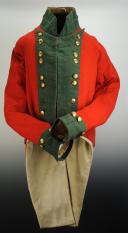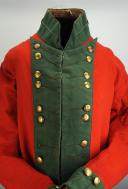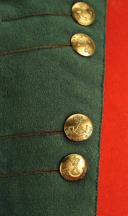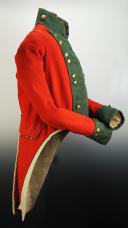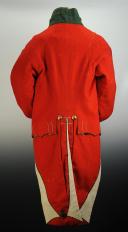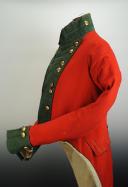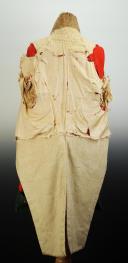
HABIT D'OFFICIER DU RÉGIMENT SICILIAN INFANTRY, COMPAGNIE DE FUSILIERS, DE L'ARMÉE BRITANIQUE, 1809-1812.
Sold out
HABIT D'OFFICIER DU RÉGIMENT SICILIAN INFANTRY, COMPAGNIE DE FUSILIERS, DE L'ARMÉE BRITANIQUE, 1809-1812.
Habit en drap écarlate. Collet, revers, parements, et passepoils en drap vert.
Revers coupés droit en partie basse, bordant le collet en forme de pointe dans les parties hautes, chacun est bordé de neuf larges boutonnières (74 mm) garnies de boutons d'uniforme grand module en laiton doré timbré d'un cor de chasse surmonté de la couronne royale avec dans le bas l'inscription «SICILIAN REGT», D 20 mm. Une boutonnière dans le haut, puis les boutonnières sont placée par deux, c'est une disposition de juillet 1809. Les bord de l'uniforme sont garnis de 11 crochets au niveau des revers.
Collet garni de chaque côté d'une boutonnière avec bouton d'uniforme.
Fausses poches arrières passepoilées vert formant trois pointes, elles sont garnies de quatre boutonnières chacune avec un bouton d'uniforme. deux autres boutons sont placé à la taille.
Basques avec revers en drap blanc passepoilé vert. Entre les pointes des basque est cousu un insigne sur drap bleu foncé brodé or d'un cor de chasse surmonté de la couronne royale, H 41 mm, L 31 mm.
Passants d'épaulettes en drap écarlate.
Doublure intérieure en soie blanche, accidents et manques.
Très bon état, quelques trous de mite.
Grande Bratagne.
1809-1812.
Sicilian Regiment Raised in Sicily from May 1806 as a light infantry battalion of 500 men by Major General Sir John Stuart. It was part of Stuart’s army which beat the French at Maida on 4 July although the unit, hardly raised and disciplined, was put in reserve. Back in Sicily, it was raised to ten companies. Some 24 officers and 548 men took part in the unsuccessful expedition to Egypt in March 1807. It seems to have been held in reserve as it had only seven killed and ten wounded at Alexandria. It was evacuated on 19 September. Two companies were added in 1808. Each company had four officers, six sergeants, five corporals, four acting corporals, an artisan, ten carabiniers (elite sharpshooters apparently armed with rifles since they had sword bayonets), two buglers and 68 privates for a total of 100 officers and men. While in Malta, the regiment was presented with colours on 2 March 1809. It was later stationed in Sicily until disbanded on 24 April 1816.
Sicilian Regiment, fusilier, c. 1810 According to a c. 1810 entry in the Pearse notebook, the enlisted men had a red “private jacket, 10 by 2 double headed, 12 yards looping lace, 30 small buttons, dark green facings” with a piece of white lace with green central line pasted on the page. For the “drum [actually bugler’s] coat, 30 small buttons, broad lace seams frames, body and cuffs, 10 yards broad lace, 15 yards of narrow”. The buglers would have had a green coatee with red collar and cuffs with the lace edging the seams but without sleeve chevrons. The officers had gold buttons, wing of dark green with plain gold scales and “flat braid on each side” with silver bugle and “no bullions” fringes. Gold bugle with laurel badge on dark green at turnback, gold lace triangle at back waist (Herbert's). The chaplain was to wear a black cassock with the crucifix hanging from his neck and a tassel on his priest’s cap. The 1813 standing orders mention a “casco” for head dress which has been interpreted as a helmet but “casco” could also mean cap which was synonymous to shako. We have opted for the shako as the more typical and less expensive headgear. (Pearse Notebook, Canadian War Museum; Fosten, Don, “His Majesty’s Sicilian Regiment”, Military Modelling, November 1990)
REMERCIEMENTS :
Je remercie René Chartrand, spécialiste canadien en uniformologie, pour m'avoir aider à compléter cette identification.
Habit en drap écarlate. Collet, revers, parements, et passepoils en drap vert.
Revers coupés droit en partie basse, bordant le collet en forme de pointe dans les parties hautes, chacun est bordé de neuf larges boutonnières (74 mm) garnies de boutons d'uniforme grand module en laiton doré timbré d'un cor de chasse surmonté de la couronne royale avec dans le bas l'inscription «SICILIAN REGT», D 20 mm. Une boutonnière dans le haut, puis les boutonnières sont placée par deux, c'est une disposition de juillet 1809. Les bord de l'uniforme sont garnis de 11 crochets au niveau des revers.
Collet garni de chaque côté d'une boutonnière avec bouton d'uniforme.
Fausses poches arrières passepoilées vert formant trois pointes, elles sont garnies de quatre boutonnières chacune avec un bouton d'uniforme. deux autres boutons sont placé à la taille.
Basques avec revers en drap blanc passepoilé vert. Entre les pointes des basque est cousu un insigne sur drap bleu foncé brodé or d'un cor de chasse surmonté de la couronne royale, H 41 mm, L 31 mm.
Passants d'épaulettes en drap écarlate.
Doublure intérieure en soie blanche, accidents et manques.
Très bon état, quelques trous de mite.
Grande Bratagne.
1809-1812.
Sicilian Regiment Raised in Sicily from May 1806 as a light infantry battalion of 500 men by Major General Sir John Stuart. It was part of Stuart’s army which beat the French at Maida on 4 July although the unit, hardly raised and disciplined, was put in reserve. Back in Sicily, it was raised to ten companies. Some 24 officers and 548 men took part in the unsuccessful expedition to Egypt in March 1807. It seems to have been held in reserve as it had only seven killed and ten wounded at Alexandria. It was evacuated on 19 September. Two companies were added in 1808. Each company had four officers, six sergeants, five corporals, four acting corporals, an artisan, ten carabiniers (elite sharpshooters apparently armed with rifles since they had sword bayonets), two buglers and 68 privates for a total of 100 officers and men. While in Malta, the regiment was presented with colours on 2 March 1809. It was later stationed in Sicily until disbanded on 24 April 1816.
Sicilian Regiment, fusilier, c. 1810 According to a c. 1810 entry in the Pearse notebook, the enlisted men had a red “private jacket, 10 by 2 double headed, 12 yards looping lace, 30 small buttons, dark green facings” with a piece of white lace with green central line pasted on the page. For the “drum [actually bugler’s] coat, 30 small buttons, broad lace seams frames, body and cuffs, 10 yards broad lace, 15 yards of narrow”. The buglers would have had a green coatee with red collar and cuffs with the lace edging the seams but without sleeve chevrons. The officers had gold buttons, wing of dark green with plain gold scales and “flat braid on each side” with silver bugle and “no bullions” fringes. Gold bugle with laurel badge on dark green at turnback, gold lace triangle at back waist (Herbert's). The chaplain was to wear a black cassock with the crucifix hanging from his neck and a tassel on his priest’s cap. The 1813 standing orders mention a “casco” for head dress which has been interpreted as a helmet but “casco” could also mean cap which was synonymous to shako. We have opted for the shako as the more typical and less expensive headgear. (Pearse Notebook, Canadian War Museum; Fosten, Don, “His Majesty’s Sicilian Regiment”, Military Modelling, November 1990)
REMERCIEMENTS :
Je remercie René Chartrand, spécialiste canadien en uniformologie, pour m'avoir aider à compléter cette identification.
Reference :
169
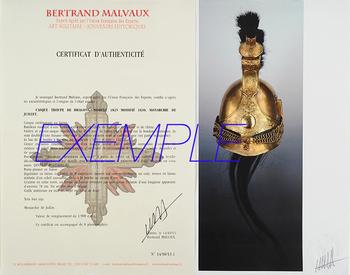
Next update Friday, december 26 at 13:30 PM
FOR ALL PURCHASES, PAYMENT IN MULTIPLE CHECKS POSSIBLE
bertrand.malvaux@wanadoo.fr 06 07 75 74 63
SHIPPING COSTS
Shipping costs are calculated only once per order for one or more items, all shipments are sent via registered mail, as this is the only way to have proof of dispatch and receipt.
For parcels whose value cannot be insured by the Post, shipments are entrusted to DHL or Fedex with real value insured, the service is of high quality but the cost is higher.
RETURN POLICY
Items can be returned within 8 days of receipt. They must be returned by registered mail at the sender's expense, in their original packaging, and in their original condition.
AUTHENTICITY
The selection of items offered on this site allows me to guarantee the authenticity of each piece described here, all items offered are guaranteed to be period and authentic, unless otherwise noted or restricted in the description.
An authenticity certificate of the item including the description published on the site, the period, the sale price, accompanied by one or more color photographs is automatically provided for any item priced over 130 euros. Below this price, each certificate is charged 5 euros.
Only items sold by me are subject to an authenticity certificate, I do not provide any expert reports for items sold by third parties (colleagues or collectors).
FOR ALL PURCHASES, PAYMENT IN MULTIPLE CHECKS POSSIBLE
bertrand.malvaux@wanadoo.fr 06 07 75 74 63
An authenticity certificate of the item including the description published on the site, the period, the sale price, accompanied by one or more color photographs is automatically provided for any item priced over 130 euros. Below this price, each certificate is charged 5 euros.
Only items sold by me are subject to an authenticity certificate, I do not provide any expert reports for items sold by third parties (colleagues or collectors).
